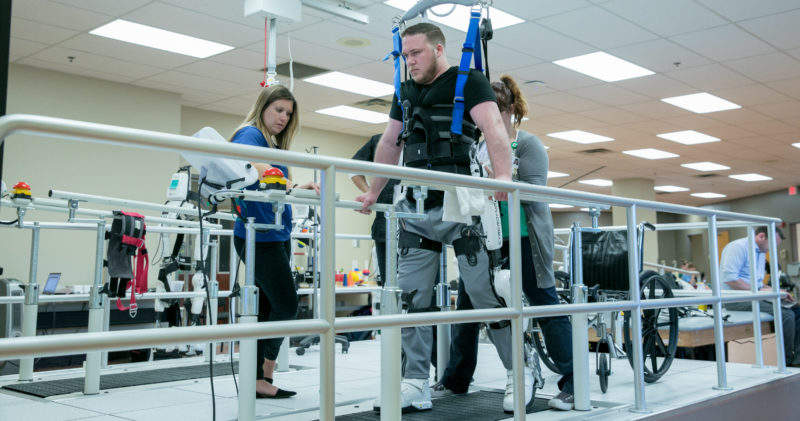
Injuries and conditions leading to lower limb disorders, including spinal cord injuries and cerebral embolisms, can feel like life-ruining events to patients. Treatments, if any can be prescribed, can be lengthy and uncomfortable, often leading to extreme frustration and despair. In the US alone, an estimated 10,000 to 12,000 spinal cord injuries occur every year, with around 200,000 Americans currently living with related conditions.
The Hybrid Assistive Limb (HAL) is a powered exoskeleton suit developed by Japanese robotics technology company Cyberdyne that has been used in Japanese medical institutions since 2008 for the treatment of lower limb disorders. By 2012 more than 300 HAL suits were in use across Japan, by 130 different medical facilities. Now the technology has made its way over to the US, receiving Food and Drug Administration (FDA) clearance in 2017.
How well do you really know your competitors?
Access the most comprehensive Company Profiles on the market, powered by GlobalData. Save hours of research. Gain competitive edge.

Thank you!
Your download email will arrive shortly
Not ready to buy yet? Download a free sample
We are confident about the unique quality of our Company Profiles. However, we want you to make the most beneficial decision for your business, so we offer a free sample that you can download by submitting the below form
By GlobalDataBrooks Rehabilitation, post-acute physical rehabilitation specialists based in Florida, announced a partnership Cyberdyne in March 2018 – since then it has become the first US-based provider of HAL treatments through the new Brooks Cybernic Treatment Center in Jacksonville, FL.
Reading bioelectric signals to work with the brain and body
According to Cyberdyne, HAL is the world’s first cyborg-type robot, leading to a ‘fusion of man, machine and information’. In medical settings though, HAL is a machine that works with patients to improve their physical function so they can walk again. The goal isn’t a ‘fusion of man and machine’, rather, to help patients reach a place where they don’t need to rely on the technology at all, achieving freedom of movement, without machinery and support.
“HAL works by using small sensors on the skin that detect minor electrical signals in a patient’s body,” explains Brooks Rehabilitation director of clinical technology Robert McIver, “As those signals are detected by the robot, it responds with a movement at the joint. It is the only system that I have come across where the patient’s nervous system acts on an external device.”
Even in patients whose movement is limited or even completely paralysed, the skin still outputs bio-electric signals from the brain that reflect the individual’s intention to move. The HAL technology reads these signals and the suit provides motion assistance in-line with what the brain is trying to achieve.
“The treatment intervention with HAL is truly in response to what signals the patient’s brain is sending in relation to walking,” says McIver. While the patients currently going through the treatment at Brooks have reported this relates to a very different, harder experience than other therapies, McIver claims that they’ve seen greater functional changes in a shorter amount of time than in any other intervention method they’ve tried in spinal cord injured patients. The Brooks Cybernic Treatment Center opened in February 2018, and in May completed the treatment of its first two patients.
The HAL unit was initially designed to assist disabled or elderly individuals, however, in addition to its medical applications further development has allowed HAL to be used in situations that look more suited to works of science-fiction. HAL suits can support workers with physically demanding jobs, enhancing the strength of users, or can be customised for disaster recovery, reinforced with titanium, a radiation shielding jacket and an on-board cooling system.
Upsetting the status quo in the US medical device market
Cyberdyne received approval and market clearance for the ‘HAL for Medical Use (Lower Limb Type)’ model from the FDA in 2017. This meant the exoskeleton was now approved for use in the US – it was previously only available in Japan and the EU.
This technology is not the first of its kind to be available in the US, with ReWalk, Ekso Bionics and Indego all offering walking assistance and rehabilitative powered exoskeletons to healthcare facilities. For HAL though, Cyberdyne tried to demonstrate to the FDA the differences between its tech and exoskeletons already available on the US market – the most notably being the reading surface bioelectric signals from the patient’s nervous system, but also the fact that the end-goal of HAL is that the technology is not needed at all – the aim for treatment is for there to be an increase in patients’ function without wearing the HAL exoskeleton, rather than having to rely on it.
Cyberdyne’s efforts have led to its technology being the only powered exoskeleton that is classified under the categories of both Physical Medical Devices §21 CFR 890.3480 as well as Neurological Devices §21 CFR 882.5050.
For HAL, the FDA only needed a six-month turnaround, which was far quicker than for other exoskeleton health products, implying the US has started to see powered medical exoskeletons as standard within the remit of the medical device sector. Following its evaluation of HAL, the FDA has updated its classification on medical exoskeleton products, demonstrating the effect Cyberdyne’s technology has directly had on the US marketplace.
The definition of a powered exoskeleton itself has also changed to: “a prescription device that is composed of an external, powered, motorised orthosis that is placed over a person’s paralysed or weakened lower extremity limb(s) for medical purposes.” – from the outdated previous classification of: “a prescription device that is composed of an external, powered, motorised orthosis used for medical purposes that is placed over a person’s paralysed or weakened limbs for the purpose of providing ambulation.”
HAL is already upsetting the status quo in the US medical device sector, and for Brooks at least, it looks as though Cyberdyne will continue to shake up the market, with McIver commenting that “We are just scratching the surface of what HAL can do for our patients. It is ground breaking technology…We look forward to working with Cyberdyne Inc to bring more of their technology to the United States and help with applications to many different types of patients.”




